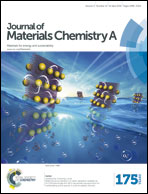Grafting sulfonic and amine functional groups on 3D graphene for improved capacitive deionization†
Abstract
A novel ion-selective 3D graphene electrode was rationally designed and originally prepared to overcome the co-ions expulsion effect and improve the desalination performance in the capacitive deionization (CDI) process. The electrodes were fabricated by grafting sulfonic and amine functional groups on three-dimensional graphene (3DGR) using an aryl diazonium salt solution and 3-aminopropyltriethoxysilane, respectively. These grafted groups can act as ion-selective functional coatings, which can minimize the co-ions expulsion effect and increase the charge efficiency. In addition, they can increase the hydrophilicity and wettability of the electrode surface, which is beneficial for ion transmission from the solution to the electrode. The CDI performance of functionalized 3DGR was evaluated at various operating conditions by four flow-through capacitors assembled with different combinations of the sulfonated, aminated and original 3DGR. The CDI performances of the flow-through capacitor based on the ion-selective 3DGR were improved in both salt adsorption capacity and charge efficiency. The results show that the capacitor exhibits a salt adsorption capacity of 13.72 mg g−1 in a 500 mg L−1 NaCl aqueous solution and the charge efficiency reaches 0.85. The improved desalination performance was attributed to the reduced co-ions expulsion effect by ion-selective groups on the 3DGR.


 Please wait while we load your content...
Please wait while we load your content...